An essential part of NASA’s plan to return American astronauts to the Moon this decade is the Lunar Gateway—a 40-ton space station that will serve as humanity’s first long-term outpost beyond Low Earth Orbit (LEO). [The International Space Station (ISS) currently operates in LEO and has not ventured beyond it, as the Lunar Gateway will.]
The Lunar Gateway (or simply Gateway) will be an outpost orbiting the Moon, playing a crucial role in supporting human missions back to the lunar surface over extended periods, as well as serving as a staging point for deep space exploration (such as Mars). It is a vital component of NASA’s Artemis program.
Alongside the Space Launch System (SLS), the Orion spacecraft, and the Human Landing System that will transport astronauts to the Moon, the Gateway is one of four key elements in NASA’s deep space exploration plan.
The Gateway is a collaborative effort between NASA, the Canadian Space Agency (CSA), the European Space Agency (ESA), and the Japan Aerospace Exploration Agency (JAXA), aimed at supporting lunar surface operations while also serving as a staging point for future Mars exploration.
The Gateway will be significantly smaller than the International Space Station (ISS), initially consisting of two modules, with additional modules to be added over time. The first components of the station to reach lunar orbit will be the Power and Propulsion Element (PPE) attached to the Habitation and Logistics Outpost (HALO), expected to launch together on SpaceX’s Falcon Heavy rocket in November 2024.
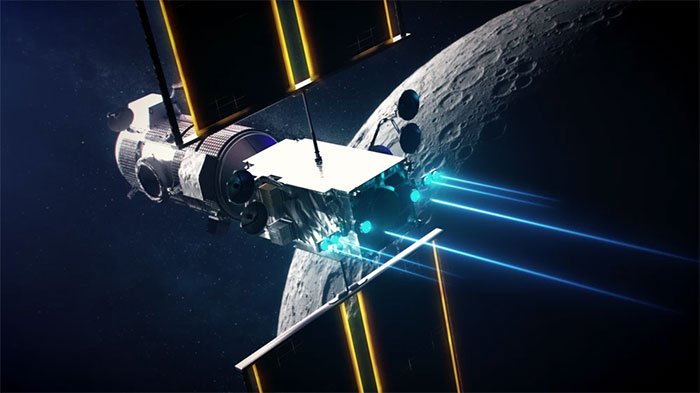
Rendering of PPE and HALO in lunar orbit.
The PPE is a solar-powered spacecraft with a capacity of 60 kilowatts, designed to provide power, high-speed communication, attitude control, and orbital maneuvering capabilities for the Gateway. [In May 2019, NASA selected Maxar Technologies, a space technology company based in Westminster, Colorado, to develop and build the PPE].
HALO is the first crew module for astronauts visiting the Gateway. Its primary purpose is to provide basic life support needs for astronauts after they arrive on Orion and prepare for their journey to the lunar surface. [HALO is being developed by Northrop Grumman (USA) and managed at NASA’s Johnson Space Center in Houston, Texas].
In February 2021, NASA selected SpaceX to provide launch services for PPE and HALO. After integration on Earth, PPE and HALO are targeted to launch together no earlier than November 2024 on the Falcon Heavy rocket from Launch Complex 39A at Kennedy Space Center in Florida, USA.
Lunar Gateway – The First Space Station Beyond LEO
The reason the Gateway is relatively small is that for most of the year, the station will not have astronauts living and working aboard. This presents some unique challenges for the Gateway. On the ISS, astronauts spend a significant amount of time maintaining the station, but the Gateway will need to operate autonomously for long periods without any direct human support.
Julia Badger, the Gateway’s automation systems director at NASA’s Johnson Space Center, explains: “The tasks that the crew performs on the International Space Station (ISS) will need to be handled autonomously by the Gateway. There is also a significant difference in the operational model. Currently, the ISS has full-time mission control. With the Gateway, we anticipate the ground station on Earth will only be operational for 8 hours a week. Hundreds of commands that the ISS receives daily (from the ground) to maintain operations will still be necessary on the Gateway, but the difference is those commands will come from the Gateway itself, rather than from humans on Earth.”
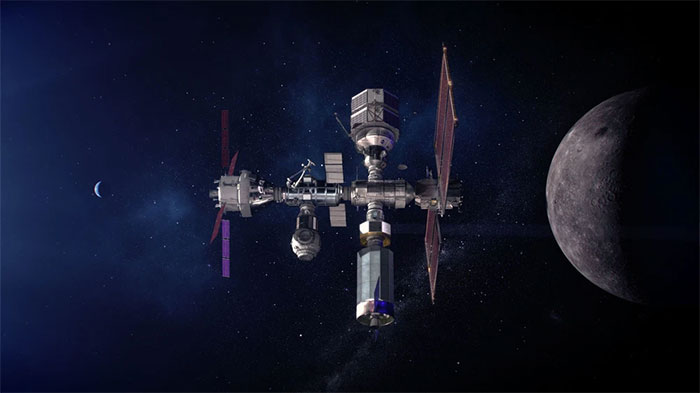
Rendering of the Gateway space station orbiting the Moon. (Source: NASA).
To make this a reality, NASA is developing a Vehicle System Manager (VSM), which will function like a ubiquitous computer system found on most science fiction spacecraft. The VSM will autonomously manage all functions of the Gateway, handling any issues that arise to the extent that it can manage them with intelligent software and sometimes with remote human assistance.
Julia Badger explains: “This is a new way of thinking compared to the ISS. If something breaks on the Gateway, we may be able to ‘live with it’ for a certain period, or we need to have the ability to repair it remotely or automatically.”
Although the Gateway itself can be seen as a type of robot, there is a limited amount that can be reasonably and effectively accomplished through specialized automated systems, and NASA has had to find a balance between redundancy and both complexity and mass. For example, there have been discussions about whether the Gateway’s hatches should operate automatically, and NASA ultimately decided to allow the hatches to be operated manually. But that does not necessarily mean that the Gateway will not be able to open hatches without human assistance.
1. Technology on the Gateway: In-Station Robots (IVR)
Julia Badger told us: “I hope we will ultimately have robots that can open hatches.” She explains that the Gateway is being designed with potential In-Station Robots (IVR). “What we are trying to do is make smart design choices for the Gateway that do not create excessive mass while also making it easier for robots to work in the station.”
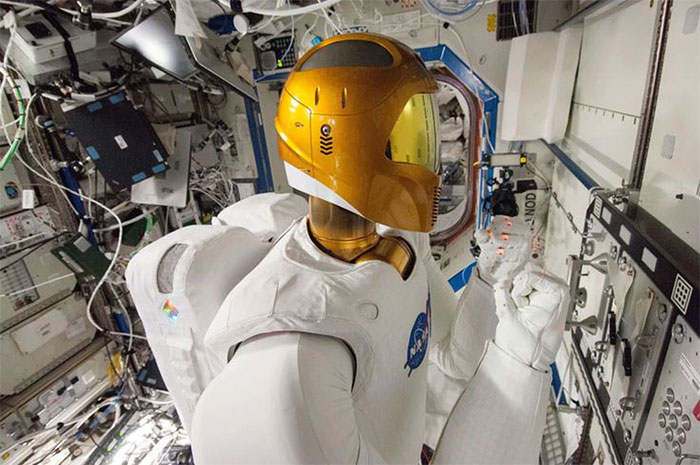
Robot astronaut at its testing station in front of the task manipulation board on the ISS. (Source: JSC/NASA)
NASA has significant experience with IVR. Robonaut 2—a full-sized humanoid robot—spent several years on the International Space Station starting in 2011, learning to perform tasks that otherwise astronauts would have to do.
More recently, a trio of free-flying robots, about the size of a toaster, called Astrobee have resided on the ISS, where they are testing sensors and autonomous navigation.
A NASA project called ISAAC (Integrated System for Autonomous and Adaptive Care) is currently exploring how robots like Astrobee can be used for various tasks on the Gateway, from monitoring the station’s status to autonomously transporting cargo.
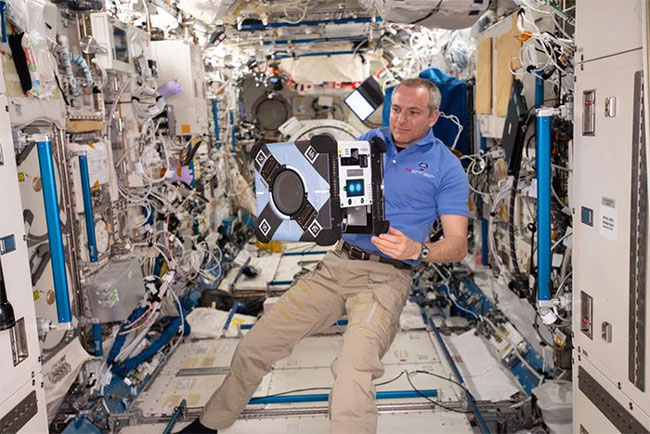
An ISS astronaut holding an Astrobee robot (named Bumble) on the ISS. (Photo: JSC/NASA)
NASA is actively working with partners to prepare for the deployment of IVR robots on the Gateway. However, creating IVR robots is not an overnight process.
It is likely that at least in the initial years, the Gateway will have to take care of itself without an internal robotic assistant. However, one of the goals of the Gateway is to operate completely autonomously for up to 3 weeks without any contact with Earth—Similar to the 3-week period during the Solar Conjunction—the time when Earth and Mars, in their eternal journey around the Sun, are obscured from each other by the blazing sphere of the Sun. This is when the Sun blocks all communication between Earth and Mars (of course, in the case that the two planets are connected).
2. Technology on the Gateway: Robotic Arm
The IVR robots are only half of the robotic team needed to keep the Gateway operating autonomously for long periods in lunar orbit.
Space stations rely on complex infrastructure outside the station to provide power, propulsion, thermal control, and more. Since 2001, the ISS has been home to Canadarm2—a 17.6-meter robotic arm that can move around the station to grasp and manipulate objects under the control of humans from inside the station or from the ground.
The Canadian Space Agency (CSA), in collaboration with the space technology company MDA, is developing a new robotic arm system for the Gateway, called Canadarm3, expected to launch in 2027.
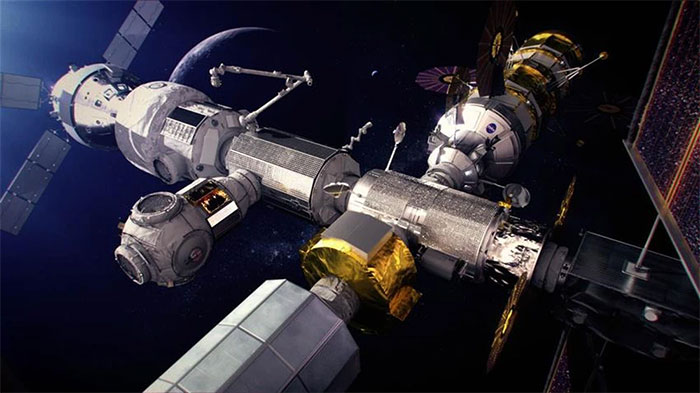
Rendering of Canadarm3 outside the Gateway space station. (Source: CSA)
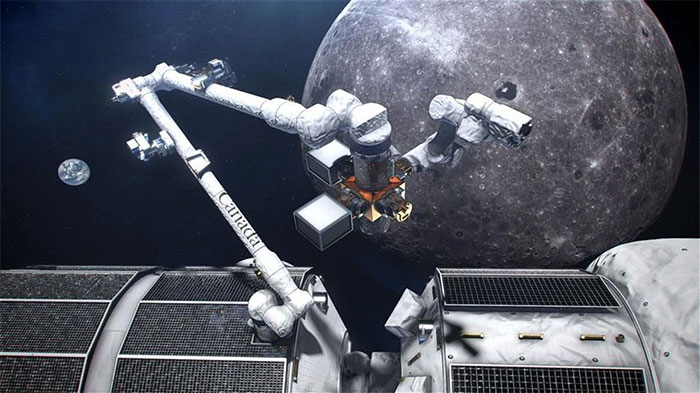
Close-up of the Canadarm3 robotic arm. (Source: CSA)
Canadarm3 will feature an 8.5-meter-long arm designed to perform operations with spacecraft and move large objects. It will also include a smaller, more dexterous robotic arm that can be utilized for intricate tasks. The smaller robotic arm can even repair the larger arm if necessary. What truly sets Canadarm3 apart from its predecessors is the way it is controlled, according to Daniel Rey, Chief Engineer of Gateway and Systems Manager at the Canadian Space Agency (CSA).
“One of the most novel aspects of Canadarm3 is its ability to operate autonomously without any crew on board. This capability is based on a new generation of software and hardware that provides a sense of touch for the arm, as well as the ability to respond to its environment without direct human oversight,” Daniel Rey stated.
The autonomous missions of Canadarm3 on Gateway will include external inspections, unloading logistical vehicles, deploying payloads, and repairing Gateway by swapping out damaged components with spare parts.
Although the Gateway station will be thousands of times farther from Earth than the International Space Station (ISS), Daniel Rey explains that the additional distance (approximately 400,000 kilometers) is not the key factor for Canadarm3’s enhanced autonomous operation.
“Surprisingly, the position of the Gateway station in its lunar orbit has a signal transmission delay to Earth that is no different from the delay experienced in low Earth orbit (LEO) with ground control. With Canadarm3, we realize that if we want to prepare for Mars, we need to build robotic arms with even more autonomous operational capabilities,” he added.


















































